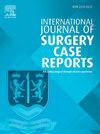Spontaneous true brachial artery aneurysm: A case report from Somalia
IF 0.6
Q4 SURGERY
引用次数: 0
Abstract
Introduction and importance
True brachial artery aneurysms are rather uncommon, due to their number of etiological factors. Besides inducing symptoms such as hand or digit ischemia, they may present as pulsative tumefactions and cause pain or paresthesias through nerve impingement. The diagnosis is based on duplex ultrasonography, CTA in the operational planning phase, and a physical examination.
Case presentation
A 28 year old female patient was attending our center with pain and swelling of the left arm because of a brachial artery aneurysm. The patient underwent successful excision of the aneurysmal sac followed by brachial artery reconstruction with a prosthetic graft.
Clinical discussion
Brachial artery aneurysms are defined as dilation greater than 50 % of the normal diameter. The pathophysiologic mechanism of brachial artery aneurysms involves local hemodynamic factors such as increased flow that lead to endothelial production of nitric oxide and reactive oxygen species, resulting in upregulation of matrix metalloproteinase production and damage to the arterial wall.
Conclusion
There is some evidence linking the creation of an AVF with the occurrence of BAA. Immunosuppression might also add to the charter of risk factors leading to aneurysmal events. Surgical repair is generally the method of choice although in selected cases, the endovascular approach may be employed. When an autologous vein is not available, the use of a synthetic graft may be a reasonable option when performing artery reconstruction.
求助全文
约1分钟内获得全文
求助全文
来源期刊
CiteScore
1.10
自引率
0.00%
发文量
1116
审稿时长
46 days

 求助内容:
求助内容: 应助结果提醒方式:
应助结果提醒方式:


